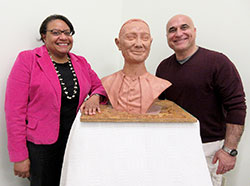Bust of Cardinal Ritter is unveiled at Irish coffee event

Dr. Cecilia A. Moore, featured speaker, and sculptor Guy Tedesco pose with Tedesco’s clay bust of Cardinal Joseph E. Ritter, which was unveiled at the Cardinal Ritter House Irish coffee event in New Albany on March 14. The “study bust” will later be cast in bronze. (Photo by Patricia Happel Cornwell)
By Patricia Happel Cornwell (Special to The Criterion)
NEW ALBANY—When a crowd of about 50 gathered for the fourth annual Irish coffee lecture at the Cardinal Ritter Birthplace in New Albany on March 14, they were treated to more than the traditional Irish beverage.
Dr. Cecilia A. Moore of the University of Dayton gave an energetic presentation on “Cardinal Ritter, Black Lives Matter, and Bridging the Racial Divide.” In the corner of the community room stood a surprise for those in attendance—a clay bust of New Albany native Cardinal Joseph E. Ritter by southern Indiana sculptor Guy Tedesco.
Moore, the evening’s speaker, is associate professor of religious studies at the University of Dayton and adjunct professor for the Institute for Black Catholic Studies at Xavier University of Louisiana. She is working on a history of black conversion to Roman Catholicism in the 20th century.
Moore said, “I love what Cardinal Ritter said when he announced he would desegregate the Catholic schools in Indianapolis: ‘The cross on the top of our schools must mean something.’ I love that!”
As bishop, Ritter desegregated Indianapolis’s then-diocesan schools from 1937 to 1943. He faced opposition from many Catholic parents and from the Ku Klux Klan. In 1947, as archbishop of St. Louis, he ordered desegregation of that archdiocese’s Catholic schools as well. This was accomplished years before the U.S. Supreme Court decision of Brown v. Board of Education made desegregation the law of the land in 1954.
“Cardinal Ritter believed segregation was not only anti-Christian, but also anti-American,” Moore said. “He based his decisions on justice. Once he did this, other bishops had the courage to do the same. Cardinal Ritter proved that nothing bad happens when we [blacks and whites] live together and learn together.”
She said the Catholic bishops provided the model for public schools that had to integrate after the Supreme Court decision.
Moore described today’s Black Lives Matter movement, begun by four young black women, as a campaign for justice, accountability and transparency regarding police actions, failing schools, unsafe housing, income disparity and other issues of inequality.
“Black Lives Matter is a black, white and Latino movement,” she said. “The Church is part of the movement. It is not anti-white, it’s anti-white supremacy. There is still racial division today, but we don’t talk about it anymore. It is real, and it is in our Church, not just in our country.”
Moore focused on a pastoral letter dealing with race published in 2015 by Bishop Edward K. Braxton of Belleville, Ill., in which he developed a program of reflection for communities to begin to heal “the racial divide.”
She quoted Bishop Braxton’s pointed reminder from his pastoral letter: “Never forget that racism is a sin. It keeps us from being who God intends us to be.”
The influence Cardinal Ritter had on race issues may soon be celebrated in a very public manner. David Hock, board president of the Cardinal Ritter Birthplace Foundation, revealed that the board is working with the Indiana State Museum in Indianapolis to create an exhibit there about the life and work of the cardinal.
Representatives of the Archdiocese of Indianapolis, Ritter family members and others are involved in the discussions, although as yet there is no timeline for the project. A bronze bust made from the clay “study bust” unveiled during the evening event would be a likely anchor for the display.
Ray Day, board secretary, said the board has been “brainstorming” with sculptor Tedesco about the creation of a life-size bronze sculpture of Cardinal Ritter, perhaps surrounded by children, to serve as the centerpiece of a planned rose garden at the property at 1218 Oak St. in New Albany. The garden would honor the cardinal’s hobby of rose gardening and provide a contemplative space for the site.
Tedesco has a studio at Mount St. Francis in Floyd County and is known for his 15-foot “cruciform” sculpture at Most Sacred Heart of Jesus Church in Jeffersonville, in which Jesus is shown crucified on one side and “rising” on the other. He said he is excited about the prospect of creating a life-size sculpture of the cardinal.
“I like to have students work with me,” he said. He added that “it would be wonderful to work on it” with art students from Cardinal Ritter Jr./Sr. High School in Indianapolis, Our Lady of Providence Jr./Sr. High School in Clarksville, and even possibly Cardinal Ritter High School in St. Louis.
“Cardinal Ritter’s life is such a great story to tell,” Tedesco continued. “When you create a significant work of art like this [sculpture of the cardinal], you’re not just representing history; you’re creating history. The art will be remembered because it’s saying something about our society. How do we tell the story of this person who was part of the change that we are still involved in today?”
(For more information about Cardinal Ritter Birthplace Foundation, log on to cardinalritterhouse.org. Patricia Happel Cornwell is a freelance writer and a member of St. Joseph Parish in Corydon.) †
